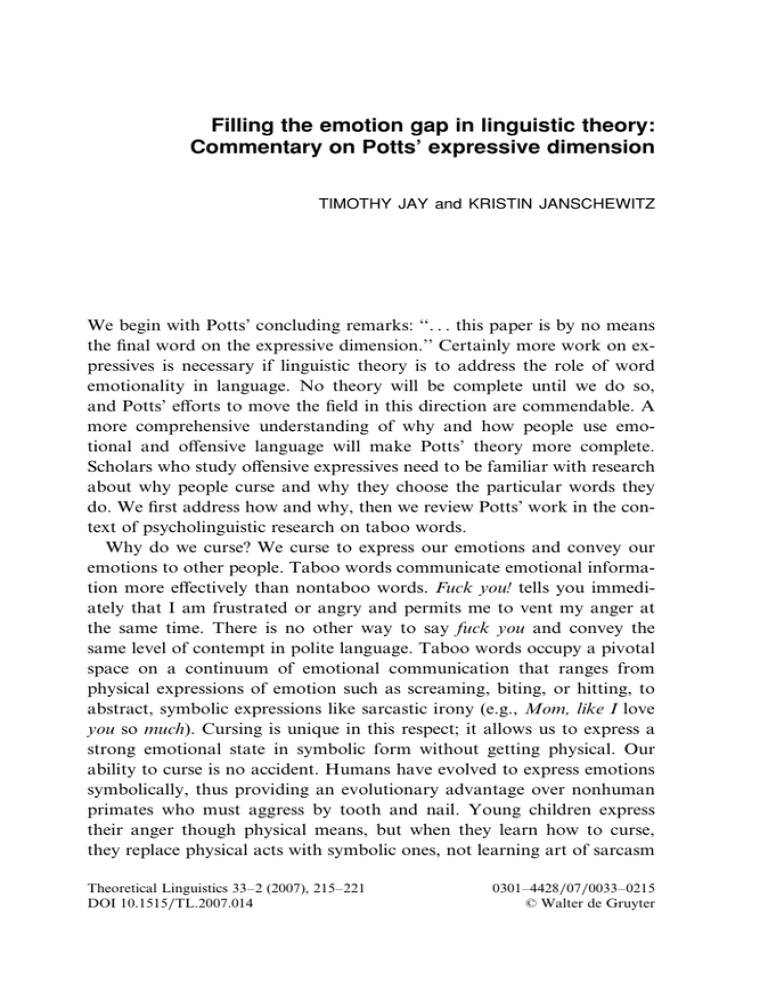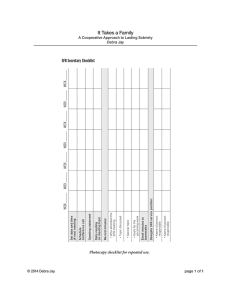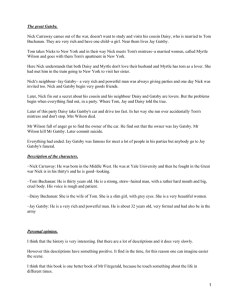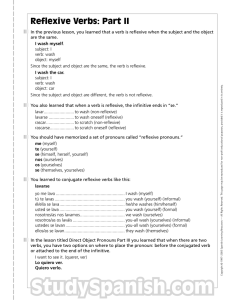Filling the emotion gap in linguistic theory: Commentary
Anuncio

Filling the emotion gap in linguistic theory: Commentary on Potts’ expressive dimension TIMOTHY JAY and KRISTIN JANSCHEWITZ We begin with Potts’ concluding remarks: ‘‘. . . this paper is by no means the final word on the expressive dimension.’’ Certainly more work on expressives is necessary if linguistic theory is to address the role of word emotionality in language. No theory will be complete until we do so, and Potts’ e¤orts to move the field in this direction are commendable. A more comprehensive understanding of why and how people use emotional and o¤ensive language will make Potts’ theory more complete. Scholars who study o¤ensive expressives need to be familiar with research about why people curse and why they choose the particular words they do. We first address how and why, then we review Potts’ work in the context of psycholinguistic research on taboo words. Why do we curse? We curse to express our emotions and convey our emotions to other people. Taboo words communicate emotional information more e¤ectively than nontaboo words. Fuck you! tells you immediately that I am frustrated or angry and permits me to vent my anger at the same time. There is no other way to say fuck you and convey the same level of contempt in polite language. Taboo words occupy a pivotal space on a continuum of emotional communication that ranges from physical expressions of emotion such as screaming, biting, or hitting, to abstract, symbolic expressions like sarcastic irony (e.g., Mom, like I love you so much). Cursing is unique in this respect; it allows us to express a strong emotional state in symbolic form without getting physical. Our ability to curse is no accident. Humans have evolved to express emotions symbolically, thus providing an evolutionary advantage over nonhuman primates who must aggress by tooth and nail. Young children express their anger though physical means, but when they learn how to curse, they replace physical acts with symbolic ones, not learning art of sarcasm Theoretical Linguistics 33–2 (2007), 215–221 DOI 10.1515/TL.2007.014 0301–4428/07/0033–0215 6 Walter de Gruyter 216 Timothy Jay and Kristin Janschewitz until late childhood. It is important to note, though, that cursing occurs with and is informative about all emotional states, not just anger and frustration. The unique emotional power of taboo language reflects properties that a¤ect cognitive processes like memory and attention. Cursing is unlike other forms of speech; it is more physically arousing, as evidenced through physiological responses such as skin conductance or neural activity such as amygdala activation (Jay, 2003; Jay, Harris, & King, in press). Recent brain imaging research and studies of clinical populations indicate that the human brain processes taboo words di¤erently than nontaboo words. Cognitive neuroscience and neuropsychological studies of emotional language make the distinction between valence and arousal as primary dimensions of emotional significance. Taboo words, principally because they are arousing, are remembered better than nontaboo words, and there is a neurological basis for this. Kensinger and Corkin (2004) investigated brain structures involved in processing emotional words using functional MRI and behavioral methodologies. Behaviorally, emotional words were associated with better memory, particularly with recollection, which is an index of the ability to vividly remember having encountered the word in the study context (versus a vague feeling of having studied the word previously). On a neural level, it appears separate mechanisms were responsible for memory enhancement of arousing versus nonarousing emotional words. Arousing words were processed via an amygdalarhippocampal pathway, while processing nonarousing emotional words relied on an hippocampal-prefrontal pathway. Additionally, di¤erences in the level of attention necessary to encode the words were found: memory enhancement for arousing words was shown to rely little on the amount of attention available to devote to encoding, while the encoding of nonarousing emotional words required conscious attention to yield memory enhancement. What are the taboo words that show these strongly emotional qualities? Records of the reflexive use of taboo language by clinical populations provide us with estimates of the most socially unacceptable forms of speech within any culture, because taboo speech is usually otherwise selfcensored. For example, automatic cursing in nonfluent aphasia or coprolalic outbursts associated with Tourette syndrome reveal social and psychological factors that contribute to the semantics (sex, excretion, Filling the emotion gap in linguistic theory 217 religion, disgust, race, etc.) of taboo language (Jay, 2000). Importantly, this is evidence that emotional expressiveness is filtered through cultural conventions and practices. For example, American males and females di¤er in their cursing practices. Females are five times more likely than males to say oh my god when upset or surprised. Males are more likely than females to say fuck, motherfucker, son of a bitch and shit in public. Males and females also use individual taboo words di¤erently; males are more likely to use ass in reference to body parts (as in She has a nice ass) than females, who are more likely than males to use ass to indicate a social deviation (as in He’s a silly ass). The remainder of our commentary addresses points of agreement and disagreement with Potts’ properties of expressives in the context of psycholinguistic research. To begin with, we address a di¤erence in the operationalization, or definition, of propositional and nonpropositional speech in the cursing literature compared to that used by Potts. We would be remiss to fail to assert that, as these uses are defined psycholinguistically, taboo language is absolutely used both propositionally and nonpropositionally (Jay, 2000). Van Lancker (1987) and others use the term nonpropositional to refer to reflexive or automatic speech, or ictal speech, which are highly overlearned and conventionalized (e.g., greetings, clichés, epithets, and exclamations). Nonpropositional speech is symptomatic in patients with left hemisphere brain damage (aphasia), Alzheimer’s dementia, epilepsy, or Tourette syndrome. Normal speakers will produce reflexive cursing under conditions of stress or surprise, as when I drop a heavy object on my foot. On the other end of the cursing spectrum is propositional speech: novel or strategic speech that is made up on the spot. An example of a dissociation between these kinds of speech is the aphasic patient who can say ‘‘shit’’ as an epithet when angry (nonpropositional) but cannot construct a sentence with shit in it when asked to do so (propositional). According to these psycholinguistic definitions, many of Potts’ examples of expressives (e.g., Kresge is a bastard ) are propositional, not nonpropositional, and it would be incorrect to say that we agree with any formulation that restricts taboo language use to nonpropositional, automatic, or reflexive forms alone. Consider the cursing experience; it follows a sequence of events over time (see Jay, 2000, p. 61). First, there is an antecedent to cursing, something that causes the emotion. Second, there is the resultant feeling or felt 218 Timothy Jay and Kristin Janschewitz emotion, a reaction to the antecedent. Finally, there is cognition, or an evaluation regarding what is happening in the scenario. Cursing is not merely ballistic or automatic; it is an emotional reaction that unfolds over time. Automatic or reflexive cursing occurs more quickly than strategic cursing but both forms are meaningful and purposeful. Herein lies the mindfulness of cursing. One can be upset and call a woman a whore but one does not call a suitcase a whore. We also find individual di¤erences; some people curse more reflexively than others; but even the reflexive is semantically appropriate. It follows that we do not agree that all speakers are ‘‘hard pressed to articulate what they mean’’ when they use expressives. As we have stated earlier, certain emotional states are only adequately expressed through taboo language. Of course, there are individual di¤erences in the way people talk about emotions. People vary in their ability to express their emotional states in words, also termed referential activity (RA; Bucci, 1997). Low RA people have trouble expressing and understanding emotions, which can be particularly evident in psychotherapy. To our knowledge, there has been no research on the relative frequency of taboo words versus other emotional terms (e.g., metaphors, which are often studied in therapy) used to express emotional states. However, we suspect that because taboo words have intrinsic strong emotionality, they would be overall more accessible for speakers to describe a¤ect. For example, a low RA client might say I feel like shit but be hard pressed to further articulate the nature of her or his emotional distress, while a high RA client would to go on to describe what shit meant in terms of feeling depressed. We agree with Potts that expressive and descriptive content are not entirely separable. While studying expressives, it is important to keep in mind that words vary semantically in terms of their denotative and connotative content. Usually when we think of word meaning, we are concerned with denotative or literal meaning. However, taboo words are unique even compared to other categories of emotion words (excluding figurative language), in that their connotative meanings are generally more important than their denotative meanings. Prenominal adjective ordering is one indicator of denotative content, as adjectives more definitive in denotation are ordered closer to the nouns they modify than less definitive adjectives (e.g., the large, red, Swiss clock). Therefore, the shitty little boy is more likely to be understood as a ‘‘bad’’ little boy, while the little Filling the emotion gap in linguistic theory 219 shitty boy is more likely to be understood as a boy who needs his diaper changed (see Jay & Danks, 1977). Still, expressives cannot be restricted to connotative interpretations alone; shitty diaper is both connotative and denotative at once. To make matters worse, individual taboo words also di¤er in how often they are used connotatively versus denotatively. For example, asshole, bitch and cunt are more likely to be used to connotatively than denotatively. Hell and Jesus Christ are used widely with both expressive connotative and descriptive denotative intent, as are shit and fuck, although their connotative use outweighs their denotative use. Ultimately, it is di‰cult to separate denotation from connotation, particularly within taboo words. We agree that expressives are immediate, that their emotional impact is on the socioemotional situation at hand, and that they are often nondisplaceable. However, the nondisplaceability principle applies mainly to the connotative meaning of taboo words, as in epithets. Taboo words are used more flexibly than Potts’ examples allow. Taboo words such as fuck can describe past, future, and conjecture. Taboo language encapsulates emotion in the immediate situation but without necessarily referring only to an immediate situation. Citational references seem to violate Potts’ property of immediacy and nondisplaceability, as in Dick Cheney told Senator Lahey to go fuck himself. Citational use is not divorced from emotional significance because it too o¤ers emotional gradability. Saying Dick Cheney said ‘go fuck yourself ’ is more expressive than saying Dick Cheney said ‘the f-word.’ Self-censorship in choosing to say f-word may be much less o¤ensive to a listener than fuck yourself. Regardless of whether we use taboo words to describe things immediately, or if they are removed a layer because they are citational, we are aware of the o¤ensiveness and appropriateness of word choices, which vary significantly depending on contextual, sociocultural, and psychological factors. On a related issue, we agree with Potts that taboo words are gradable within a denotative category; that is, all taboo words for a given referent are not emotionally equivalent, and they are not equally likely to be chosen in a given context. Emotions and expressives o¤er shades of gray, they di¤er by degree. For example, references to the male genitalia, penis, pecker, dick, cock, wiener, dong, have the same referent but the level of o¤ensiveness or arousal di¤ers across the set. We have collected plenty 220 Timothy Jay and Kristin Janschewitz of data that support Potts’ gradability argument (see Janschewitz, in preparation; Janschewitz & Mackay, in press; Jay, 1992, 2000). Taboo words are also gradable (from low to high o¤ensiveness) across di¤erent semantic categories: damn, goddamn, shit, nigger, motherfucker. We agree that racial epithets and profanity are emotionally expressive, but they differ in degree of o¤ensiveness and arousal in a given situation. In addition the personality traits of the speakers and listeners, their ethnic-racial backgrounds, and the physical setting are determinant. Highly religious people are more o¤ended than the secularly indi¤erent by profanity, for example, Mormons are not likely to produce mild taboo words such as goddamn, Jesus or Christ to vent their emotions. It follows that we agree that the meaning of taboo words depends on critically on context. How the phrase you old bastard is interpreted depends on the relationship between the speaker and listener and how and where the phrase is spoken. Even between friends, intonation and emphasis can yield di¤erent emotional reactions for both parties. We recall the intimate exchange in the movie Bulworth between Warren Beatty (Bulworth) and Halle Berry where Halle says to Bulworth, You know you’re my nigger . . . Even a hateful racial epithet can be used a¤ectionately (apparently). Finally, we agree with Potts that repeating a taboo word in a conversation can strengthen its emotive content. However, repetitive use can also result in physiological desensitization or habituation (not to mention semantic satiation), that is, one gets diminishing emotional e¤ects with repetition. Accordingly, we see individual di¤erences in the extent to which cursing contributes emotionally to conversations. Some people curse frequently with relatively little emotional impact, while others who rarely curse shock us when they do. Emotionality varies with speakers’ motivation (e.g., casual versus deliberate cursing for intensification) and audience. To conclude, the concepts of taboo words, cursing, and expressives overlap but they are not the identical. Although we appreciate the utility of a succinct definition, particularly with the intention of making emotional language more accessible to existing linguistic theories, we caution linguists to not restrict their analysis of taboo word use to the category of expressives. The everyday use of taboo language is not limited to expressives and we would fail to adequately describe the complex nature of Filling the emotion gap in linguistic theory 221 taboo words by assuming they function only in this capacity. Taboo word use reflects a wide range of intentions on the connotation-denotation (emotion-description) dimension and in depth of a¤orded emotionality. Likewise, the associated di¤erences in arousal, memory and attention that we described are not unique to emotional language under Potts’ parameters for expressives – these are complex cognitive phenomena that are still under investigation in psychology and cognitive neuroscience literature. We can consider an alternative solution, too; expand the definition of expressives to include a wider range of taboo word use in order to capture how we curse. Dept. of Psychology Massachusetts College of Liberal Arts [email protected] and Dept. of Psychology University of California at Los Angeles References Bucci, W. (1997). Symptoms and symbols: A multiple code theory of somatization. Psychoanalytic Inquiry, 17, 151–172. Janschewitz, K. (In preparation). Normative ratings for taboo and nontaboo words. Janschewitz, K., and Mackay, D. (in press). Language and emotion. Cambridge Encyclopedia of the Language Sciences. Jay, T. B. (1992). Cursing in America. Philadelphia: John Benjamins. — (2000). Why we curse. Philadelphia: John Benjamins. — (2003). The psychology of language. Englewood Cli¤s, NJ: Prentice Hall. Jay, T. B., and Danks, J. H. (1977). Ordering of taboo adjectives. Bulletin of the Psychonomic Society, 9, 405–408. Jay, T. B., Harris, C., and King, K. (in press). Memory for taboo and nontaboo words. American Journal of Psychology. Kensinger, E. A., and Corkin, S. (2004). Two routes to emotional memory: Distinct neural process for valence and arousal. Proceedings of the National Academy of Sciences, 101, 3310–3315. Van Lancker, D. (1987). Nonpropositional speech: Neurolinguistic studies. In A. Ellis (Ed.), Progress in the psychology of language, Vol. 3 (pp. 49–118). London: Erlbaum.




